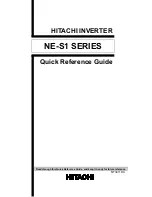
4 Mechanical Mounting
9 / 41
4 Mechanical Mounting
4.1 Safety during Mounting
DANGER
Make sure there is no electrical connection before installation.
In order to avoid electric shock or other injury, be sure there is no electricity or plumbing
installations before drilling holes.
CAUTION
Risk of injury due to improper handling
• Always follow the instructions when moving and positioning the inverter.
• Improper operation may cause injuries, serious wounds, or bruise.
System performance loss due to poor ventilation!
Keep the heat sinks uncovered to ensure heat dissipation performance.
4.2 Location Requirements
Select an optimal mounting location for safe operation, long service life, and outstanding performance.
-
The inverter with IP 66 can be installed both indoors andoutdoors.
-
Install the inverter in a place convenient for electrical connection, operation, and maintenance.
4.2.1 Installation Environment Requirements
1) Do not install the inverter on the structures constructed of flammable, thermolabile or explosive materials.
2) Ensure the inverter is out of children's reach.
3) The ambient temperature should be between -30°C to 60°C.
4) The humidity of the installation location should be below 100% without condensation.
5) Do not install the inverter outdoors in salt, sulfur or other corrosive areas.
The inverter would be corroded in salt (i.e. marine environments) area, and the corrosion may cause fire. In salt area
refers to the region within 500 meters from the coast.
Please consult the CSI Solar Co., Ltd. technical support department on the use of inverters in special climates (i.e. salt,
sulfur, or ammonia areas) which may affect the product warranty.
6) Prevent the inverter from direct exposure to sun, rain and snow.
7) The inverter should be well ventilated. Ensure air circulation
8) Never install the inverter in living areas. The inverter will generate noise during operation, affecting daily life.
9) Install at at an appropriate height for ease of viewing LED indicators and operating switches
10) Do not install in small closed cabinet where air cannot circulate freely.
FIG 4-1 Installation site
4.2.2 Carrier Requirements
The installation carrier should meet the following requirements:
Made of non-inflammable materials;
Max. load bearing capacity ≥ 4 times of inverter weight.













































